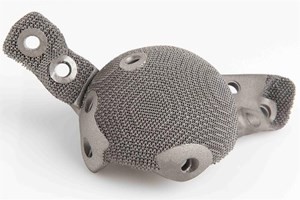 “Additive Manufacturing – potentials and risks from the viewpoint of the German machine tool industry” is the study commissioned by the German Machine Tool Builders’ Association (VDW).
“Additive Manufacturing – potentials and risks from the viewpoint of the German machine tool industry” is the study commissioned by the German Machine Tool Builders’ Association (VDW).
“Additive Manufacturing (AM) supplements the manufacturing processes available in the metalworking sector. For the time being, there is not going to be any broadly based displacement of existing machining processes, nor the much-cited revolution in industrial production operations,” says Dr. Myron Graw, a partner at KEX Knowledge Exchange AG in Aachen, speaking at the METAV’s opening press conference in Düsseldorf.
“Additive manufacturing processes are linked to high expectations,” comments Dr. Wilfried Schäfer, Executive Director of the METAV’s organiser VDW. “In particular, the vision of entirely new value creation chains right down to customised production of parts or spares on site is arousing keen interest,” he explains. Reason enough for the VDW to commission an academic study of what this actually involves from the machine tool industry’s viewpoint.
KEX AG, in conjunction with the Fraunhofer Institutes for Production Technology (IPT) and Laser Technology (ILT), conducted the study in five stages, with a major focus on metalworking operations:
· Market analysis for the development of additive processes
· Meta-analysis of already-existing studies and an as-is survey of the current situation in terms of patent applications and the research status, based on academic publications
· As-is survey of the additive processes available for the metalworking sector
· Case studies that examine the requirements and possibilities of additive manufacturing, as exemplified by selected components
· Prognosis for the development of the relevant technologies in the upcoming five to seven years
The most important result is this: assuming annual growth of 40 per cent for additive processes, less than one per cent of the existing technologies will be replaced by additive processes. This relates to the production volume of the international machine tool industry. “Overall, then, only minor shifts can be expected in the future production mix of the machine tool industry,” is Dr. Graw’s verdict. Which means that radical changes in the sector are rather unlikely.
Obstacles to greater market penetration are encountered in the costs involved and the machining time required. In small-series manufacturing, and when producing complex customised and small components, the cost advantages of an additive process can be achieved by tool-less manufacturing. A special advantage ensues when substantial added values can be generated by additive manufacturing, such as lightweight structures in the aircraft industry, cooling ducts and undercuts. That way possible cost-related disadvantages in medium-sized and large series can be compensated.
When it comes to manufacturing large components, additive processes often have cost-related disadvantages. These result not least from the comparatively low build-up rates. Other relevant factors include the expensive machinery required and the high material prices for metal powder. “These cost-drivers will in the years ahead be changed by technological advances and the upsizing of capacities,” admits Dr. Graw. This, he adds, will speed up the dissemination of AM.
The development of hybrid systems remains an exciting topic. These integrate functional quality for additive manufacturing, e.g. laser deposition welding, into conventional machinery concepts, like machining centres. This creates a potential for repeatedly performing targeted machining tasks during the build-up process. “To enable the options concerned to be efficiently utilised, however, the parts involved have to be completely redesigned. This is also true for the mere additive processes”, explains the KEX researcher. Furthermore, new approaches need to be established for production planning.
This leads to another open question: how AM systems can be integrated into the traditional production environment. Even nowadays, many work sequences are still being performed manually. For the efficient utilisation of AM, questions have to be answered regarding automated powder feed, powder handling, powder removal, dust impact on the surroundings when “unpacking” the parts, automated process chains for removing supporting structures, and much, much more.
Additive manufacturing’s other shortcomings include the still-restricted choice of materials (powder) for the additive processes. Moreover, the quality of additively manufactured components has to be tested in non-destructive mode. Since the parts involved are always more or less one-off designs, their flawless reproducibility first has to be evidenced.
“We can say that additive manufacturing in the metalworking sector is being integrated into the existing value creation chain for metalworking as an additional production technology,” is the verdict of the VDW’s Executive Director, Dr. Wilfried Schäfer. AM, he adds, will thus become another building block besides CAD, simulation, reworking, production metrology and quality assurance. AM will also become of great importance to the machine tool industry itself. For example, when additive processes add value to components, such as extending the longevity.


